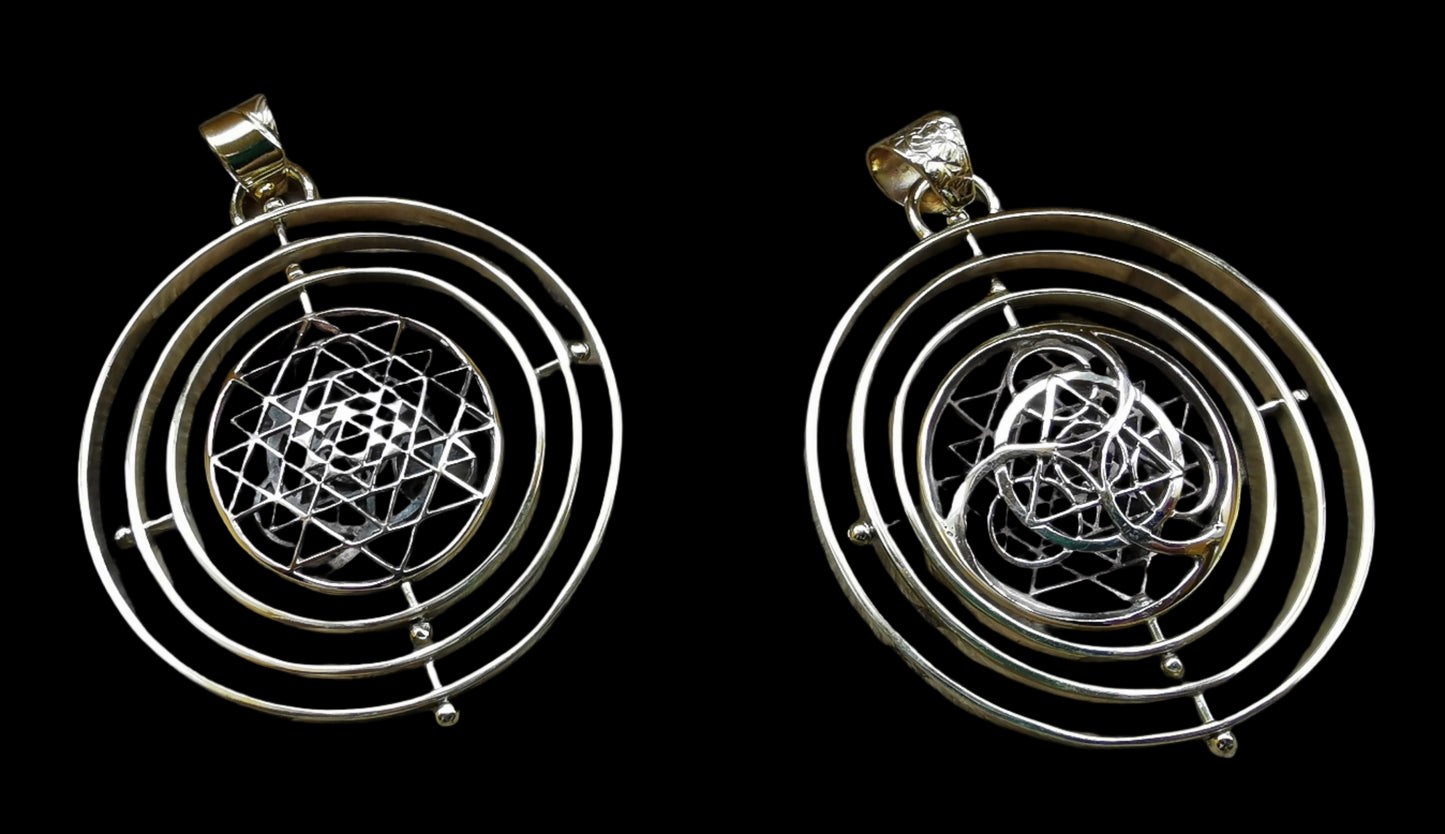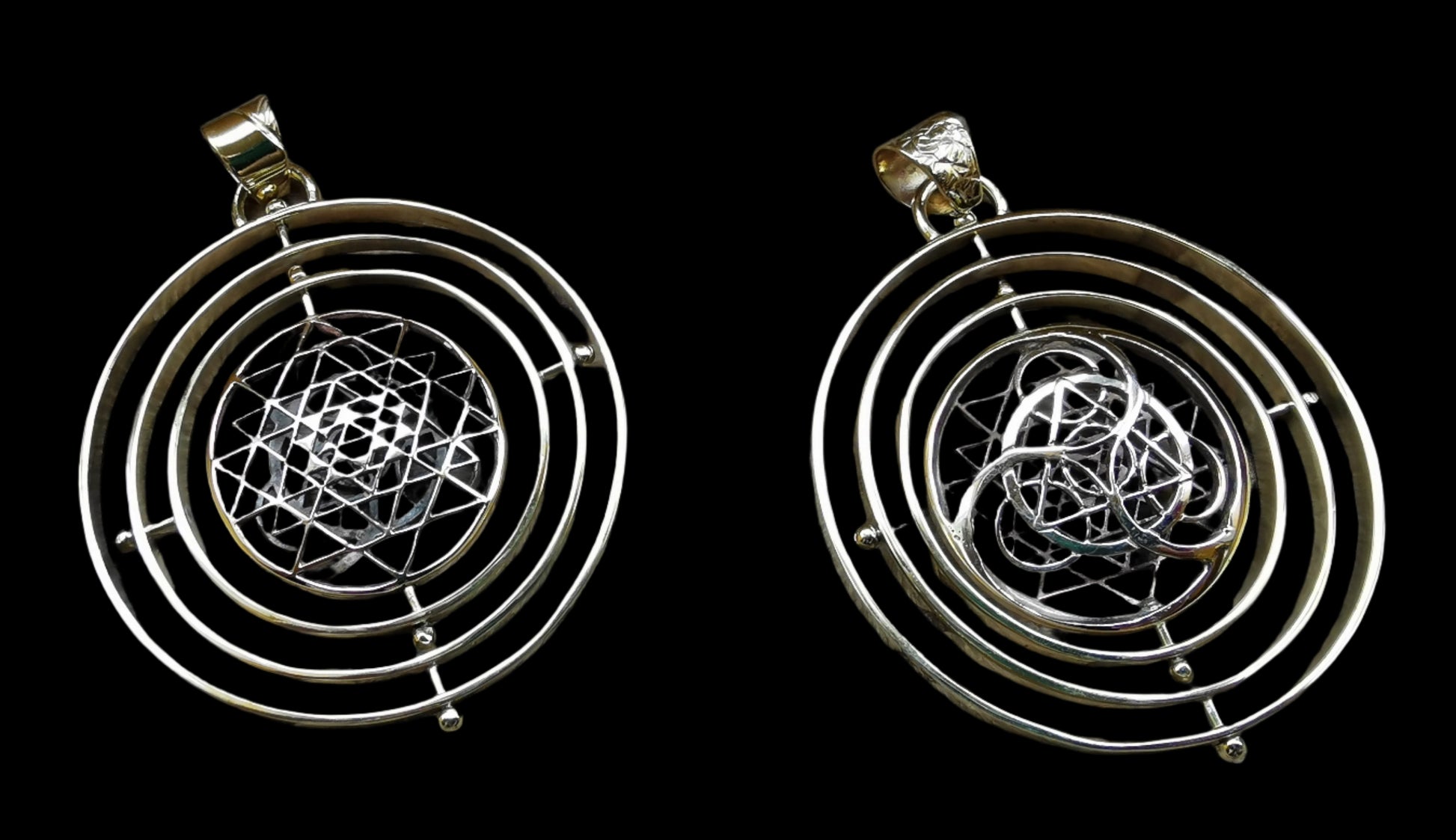Portal Glastonbury
Ref.SM0102 - Sri Yantra/Triskal Vortex
Ref.SM0102 - Sri Yantra/Triskal Vortex
Couldn't load pickup availability
Ref.SM0102 - Sri Yantra/Triskal Vortex in a double sided triple spinner medallion.
The Sri Yantra is a complex geometric figure from ancient Indian tradition, often regarded as a symbol of balance, harmony, and interconnectedness. Its structure consists of nine interlocking triangles that form a central point, surrounded by concentric layers of petals, gates, and an outer square. Here's a breakdown of its symbolism, focusing on its abstract and universal qualities rather than specific cultural or spiritual references:
Triangles: The nine triangles, with some pointing upward and others downward, represent the interplay of opposites—such as expansion and contraction, energy and matter, or movement and stillness. Their interlocking nature suggests unity and interdependence, illustrating how seemingly opposing forces can coexist and complement each other.
Central Point (Bindu): The dot at the heart of the Sri Yantra symbolizes a focal point of concentration, potential, or origin. It can be seen as the seed from which the entire structure emerges, embodying wholeness and the essence of creation in its simplest form.
Petals: The layers of petal-like shapes surrounding the triangles often evoke cycles, growth, and progression. They suggest an unfolding process, like the blossoming of complexity from a single source, emphasizing continuity and evolution.
Gates and Outer Square: The square perimeter with its four openings, or "gates," facing cardinal directions, conveys stability, structure, and boundaries. It frames the inner complexity, symbolizing a grounded foundation that contains and supports dynamic energy.
Symmetry and Balance: The Sri Yantra’s precise symmetry reflects harmony and equilibrium. Its intricate design invites contemplation of order within chaos, as the overlapping shapes create a sense of both movement and stability.
Fractal-like Quality: The repeating patterns and self-similar forms within the Sri Yantra hint at the concept of infinity and the interconnectedness of all scales, from the smallest point to the larger whole.
In essence, the Sri Yantra can be viewed as a visual representation of complexity arising from simplicity, the unity of opposites, and the balance between containment and expansion. It’s a tool for reflection, encouraging an understanding of patterns and relationships in the abstract.
The triskelion, often called the triskal or triskele, is a three-armed spiral or triple-legged motif that carries profound symbolic significance across cultures, rooted in its dynamic, cyclical design. Without invoking deities or divine references, its meaning centers on motion, progression, balance, and interconnected triads, reflecting universal patterns in nature, human experience, and philosophical thought.
Symbolic Significance
At its core, the triskelion symbolizes movement and progression. The three spiraling arms, radiating from a central point, evoke a sense of continuous motion, like waves, whirlwinds, or celestial orbits. This dynamic form represents forward momentum, personal growth, and the drive to evolve through life’s stages, suggesting that change is both inevitable and purposeful.
The triskelion’s threefold structure embodies balance and the power of triads. Each arm is equal, creating a harmonious equilibrium that mirrors natural and conceptual threes—past-present-future, birth-life-death, or earth-sea-sky. This balance symbolizes stability within flux, where distinct forces align to support a cohesive whole, encouraging adaptability and resilience.
Cyclicality is a key theme. The spiral arms suggest endless cycles, reflecting nature’s rhythms—seasons, tides, or life’s recurring phases. The triskelion symbolizes renewal, where endings lead to new beginnings, fostering trust in life’s ongoing flow and the persistence of progress through time.
Interconnectedness is also central. The arms, though separate, share a common center, symbolizing unity among diverse elements. This reflects systems like communities, ecosystems, or ideas, where individual parts contribute to a collective strength, making the triskelion an emblem of cooperation and mutual reliance.
The triskelion’s spiraling form evokes energy and vitality. Its outward expansion suggests creativity, ambition, and the unfolding of potential, while its inward curl hints at introspection and inner wisdom. This duality symbolizes the balance between external action and internal reflection, urging a holistic approach to life.
Spiritual and Philosophical Significance
Spiritually, the triskelion serves as a meditative focus, its spirals guiding the mind toward balance and progression. Contemplating its form can symbolize aligning one’s inner energies—thought, emotion, action—into a unified flow, fostering self-awareness and purposeful growth. It encourages embracing change as a path to deeper understanding.
Philosophically, the triskelion challenges static thinking. Its triadic, spiraling nature suggests that reality is dynamic, shaped by interconnected forces rather than linear or binary truths. This promotes a worldview that values complexity, encouraging synthesis of perspectives to navigate life’s intricacies.
The triskelion’s versatility allows personal interpretations. It might represent triads like family (parent-child-sibling), creativity (inspiration-process-creation), or personal growth (challenge-effort-success), making it a flexible symbol for individual or collective aspirations.
Cultural Contexts
In Celtic culture, the triskelion appears on ancient stones, like Newgrange in Ireland, symbolizing motion, life cycles, and triadic harmony, often tied to earthly elements or human phases.
In ancient Greek and Sicilian traditions, the triskelion (triskeles) represented vitality and progress, seen in coin designs symbolizing dynamic energy or regional unity.
In modern contexts, the triskelion is used in art, tattoos, and logos (e.g., the flag of Sicily), symbolizing heritage, resilience, or personal evolution.
In global esoteric practices, it’s a meditative tool, reflecting the spiral of consciousness and the interplay of life’s energies.
The triskelion’s symbolic significance weaves together movement, balance, cyclicality, and interconnectedness. It embodies the energy of progress, the harmony of triads, and the unity of life’s cycles, inviting reflection on personal growth, collective strength, and the dynamic flow of existence.
This particular Triskal was designed by Jiva Carter.
Type: medallion
Material: brass/brass
Size: 53mm/2.09in approx.


